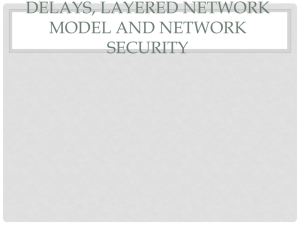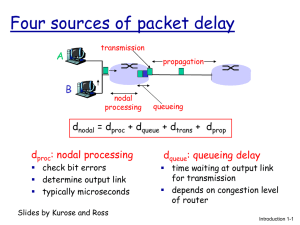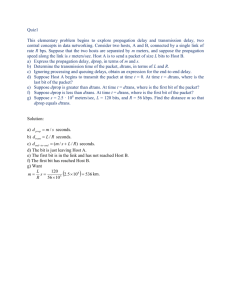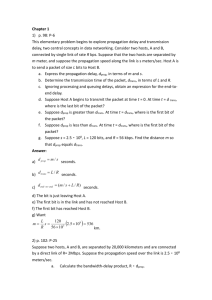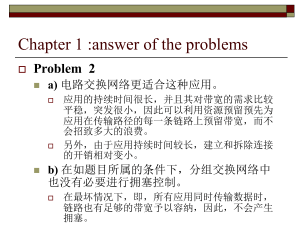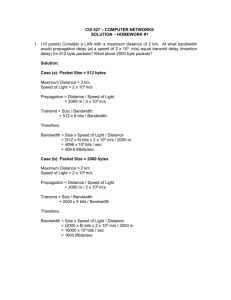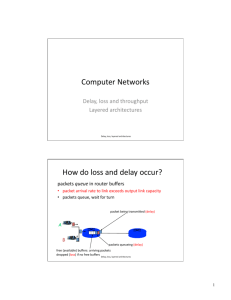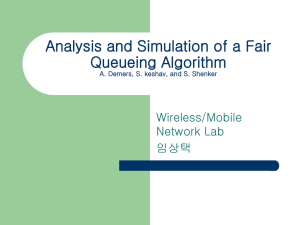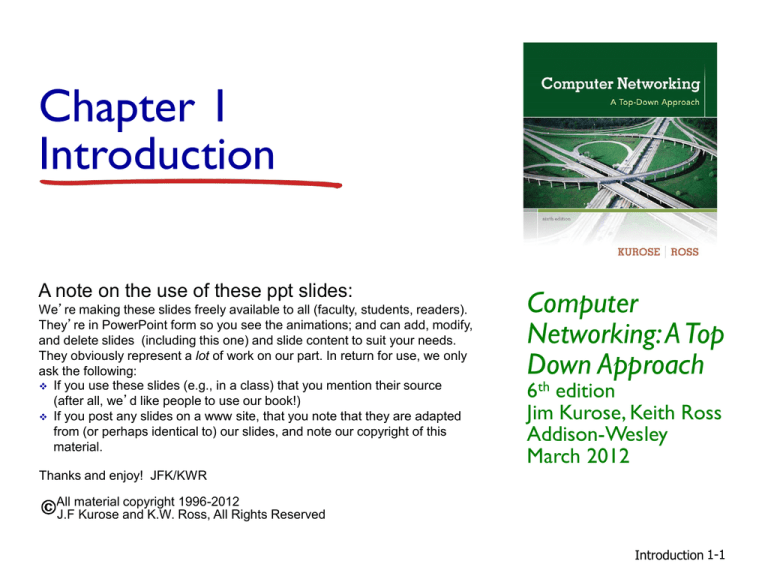
Chapter 1
Introduction
A note on the use of these ppt slides:
We’re making these slides freely available to all (faculty, students, readers).
They’re in PowerPoint form so you see the animations; and can add, modify,
and delete slides (including this one) and slide content to suit your needs.
They obviously represent a lot of work on our part. In return for use, we only
ask the following:
If you use these slides (e.g., in a class) that you mention their source
(after all, we’d like people to use our book!)
If you post any slides on a www site, that you note that they are adapted
from (or perhaps identical to) our slides, and note our copyright of this
material.
Computer
Networking: A Top
Down Approach
6th edition
Jim Kurose, Keith Ross
Addison-Wesley
March 2012
Thanks and enjoy! JFK/KWR
All material copyright 1996-2012
J.F Kurose and K.W. Ross, All Rights Reserved
Introduction 1-1
What’s a protocol?
a human protocol and a computer network protocol:
Hi
TCP connection
request
Hi
TCP connection
response
Got the
time?
Get http://www.awl.com/kurose-ross
2:00
<file>
time
Q: other human protocols?
Introduction 1-2
What’s a protocol?
human protocols:
“what’s the time?”
“I have a question”
Introductions
network protocols:
machines rather than
humans
all communication activity
in Internet governed by
protocols
protocols define format, order
of msgs sent and received
among network entities,
and actions taken on msg
transmission, receipt
Introduction 1-3
Protocol “layers”
Networks are complex,
with many “pieces”:
hosts
routers
links of various
media
applications
protocols
hardware,
software
Question:
is there any hope of
organizing structure of
network?
…. or at least our
discussion of networks?
Introduction 1-4
Organization of air travel
ticket (purchase)
ticket (complain)
baggage (check)
baggage (claim)
gates (load)
gates (unload)
runway takeoff
runway landing
airplane routing
airplane routing
airplane routing
a series of steps
Introduction 1-5
Layering of airline functionality
ticket (purchase)
ticket (complain)
ticket
baggage (check)
baggage (claim
baggage
gates (load)
gates (unload)
gate
runway (takeoff)
runway (land)
takeoff/landing
airplane routing
airplane routing
airplane routing
departure
airport
airplane routing
airplane routing
intermediate air-traffic
control centers
arrival
airport
layers: each layer implements a service
via its own internal-layer actions
relying on services provided by layer below
Introduction 1-6
Why layering?
dealing with complex systems:
explicit structure allows identification,
relationship of complex system’s pieces
layered reference model for discussion
modularization eases maintenance, updating of
system
change of implementation of layer’s service
transparent to rest of system
e.g., change in gate procedure doesn’t affect rest of
system
layering considered harmful?
Introduction 1-7
Internet protocol stack
application: supporting network
applications
FTP, SMTP, HTTP
transport: process-process data
transfer
TCP, UDP
network: routing of datagrams
from source to destination
IP, routing protocols
link: data transfer between
neighboring network elements
application
transport
network
link
physical
Ethernet, 802.111 (WiFi), PPP
physical: bits “on the wire”
Introduction 1-8
Encapsulation
source
message
segment
M
Ht
M
datagram Hn Ht
M
frame
M
Hl Hn Ht
application
transport
network
link
physical
link
physical
switch
M
Ht
M
Hn Ht
M
Hl Hn Ht
M
destination
Hn Ht
M
application
transport
network
link
physical
Hl Hn Ht
M
network
link
physical
Hn Ht
M
router
Introduction 1-9
ISO/OSI reference model
presentation: allow applications
to interpret meaning of data,
e.g., encryption, compression,
machine-specific conventions
session: synchronization,
checkpointing, recovery of data
exchange
Internet stack “missing” these
layers!
these services, if needed, must be
implemented in application
needed?
application
presentation
session
transport
network
link
physical
Introduction 1-10
Chapter 1: roadmap
1.1 what is the Internet?
1.2 network edge
end systems, access networks, links
1.3 network core
packet switching, circuit switching, network structure
1.4 delay, loss, throughput in networks
1.5 protocol layers, service models
1.6 networks under attack: security
1.7 history
Introduction 1-11
How do loss and delay occur?
packets queue in router buffers
packet arrival rate to link (temporarily) exceeds output link
capacity
packets queue, wait for turn
packet being transmitted (delay)
A
B
packets queueing (delay)
free (available) buffers: arriving packets
dropped (loss) if no free buffers
Introduction 1-12
Four sources of packet delay
transmission
A
propagation
B
nodal
processing
queueing
dnodal = dproc + dqueue + dtrans + dprop
dproc: nodal processing
check bit errors
determine output link
typically < msec
dqueue: queueing delay
time waiting at output link
for transmission
depends on congestion
level of router
Introduction 1-13
Four sources of packet delay
transmission
A
propagation
B
nodal
processing
queueing
dnodal = dproc + dqueue + dtrans + dprop
dtrans: transmission delay:
L: packet length (bits)
R: link bandwidth (bps)
dtrans = L/R
dtrans and dprop
very different
dprop: propagation delay:
d: length of physical link
s: propagation speed in medium
(~2x108 m/sec)
dprop = d/s
* Check out the Java applet for an interactive animation on trans vs. prop delay
Introduction 1-14
Caravan analogy
100 km
ten-car
caravan
toll
booth
cars “propagate” at
100 km/hr
toll booth takes 12 sec to
service car (bit transmission
time)
car~bit; caravan ~ packet
Q: How long until caravan is
lined up before 2nd toll
booth?
100 km
toll
booth
time to “push” entire
caravan through toll
booth onto highway =
12*10 = 120 sec
time for last car to
propagate from 1st to
2nd toll both:
100km/(100km/hr)= 1
hr
A: 62 minutes
Introduction 1-15
Caravan analogy (more)
100 km
ten-car
caravan
toll
booth
100 km
toll
booth
suppose cars now “propagate” at 1000 km/hr
and suppose toll booth now takes one min to service a car
Q: Will cars arrive to 2nd booth before all cars serviced at first
booth?
A: Yes! after 7 min, 1st car arrives at second booth; three
cars still at 1st booth.
Introduction 1-16
R: link bandwidth (bps)
L: packet length (bits)
a: average packet arrival
rate
average queueing
delay
Queueing delay (revisited)
traffic intensity
= La/R
La/R ~ 0: avg. queueing delay small
La/R -> 1: avg. queueing delay large
La/R > 1: more “work” arriving
than can be serviced, average delay infinite!
* Check out the Java applet for an interactive animation on queuing and loss
La/R ~ 0
La/R -> 1
Introduction 1-17
“Real” Internet delays and routes
what do “real” Internet delay & loss look like?
traceroute program: provides delay
measurement from source to router along endend Internet path towards destination. For all i:
sends three packets that will reach router i on path
towards destination
router i will return packets to sender
sender times interval between transmission and reply.
3 probes
3 probes
3 probes
Introduction 1-18
“Real” Internet delays, routes
traceroute: gaia.cs.umass.edu to www.eurecom.fr
3 delay measurements from
gaia.cs.umass.edu to cs-gw.cs.umass.edu
1 cs-gw (128.119.240.254) 1 ms 1 ms 2 ms
2 border1-rt-fa5-1-0.gw.umass.edu (128.119.3.145) 1 ms 1 ms 2 ms
3 cht-vbns.gw.umass.edu (128.119.3.130) 6 ms 5 ms 5 ms
4 jn1-at1-0-0-19.wor.vbns.net (204.147.132.129) 16 ms 11 ms 13 ms
5 jn1-so7-0-0-0.wae.vbns.net (204.147.136.136) 21 ms 18 ms 18 ms
6 abilene-vbns.abilene.ucaid.edu (198.32.11.9) 22 ms 18 ms 22 ms
7 nycm-wash.abilene.ucaid.edu (198.32.8.46) 22 ms 22 ms 22 ms trans-oceanic
8 62.40.103.253 (62.40.103.253) 104 ms 109 ms 106 ms
link
9 de2-1.de1.de.geant.net (62.40.96.129) 109 ms 102 ms 104 ms
10 de.fr1.fr.geant.net (62.40.96.50) 113 ms 121 ms 114 ms
11 renater-gw.fr1.fr.geant.net (62.40.103.54) 112 ms 114 ms 112 ms
12 nio-n2.cssi.renater.fr (193.51.206.13) 111 ms 114 ms 116 ms
13 nice.cssi.renater.fr (195.220.98.102) 123 ms 125 ms 124 ms
14 r3t2-nice.cssi.renater.fr (195.220.98.110) 126 ms 126 ms 124 ms
15 eurecom-valbonne.r3t2.ft.net (193.48.50.54) 135 ms 128 ms 133 ms
16 194.214.211.25 (194.214.211.25) 126 ms 128 ms 126 ms
17 * * *
* means no response (probe lost, router not replying)
18 * * *
19 fantasia.eurecom.fr (193.55.113.142) 132 ms 128 ms 136 ms
* Do some traceroutes from exotic countries at www.traceroute.org
Introduction 1-19
Packet loss
queue (aka buffer) preceding link in buffer has finite
capacity
packet arriving to full queue dropped (aka lost)
lost packet may be retransmitted by previous node,
by source end system, or not at all
buffer
(waiting area)
A
packet being transmitted
B
packet arriving to
full buffer is lost
* Check out the Java applet for an interactive animation on queuing and loss
Introduction 1-20
Throughput
throughput: rate (bits/time unit) at which bits
transferred between sender/receiver
instantaneous: rate at given point in time
average: rate over longer period of time
server,
withbits
server
sends
file of into
F bitspipe
(fluid)
to send to client
linkpipe
capacity
that can carry
Rs bits/sec
fluid at rate
Rs bits/sec)
linkpipe
capacity
that can carry
Rc bits/sec
fluid at rate
Rc bits/sec)
Introduction 1-21
Throughput (more)
Rs < Rc What is average end-end throughput?
Rs bits/sec
Rc bits/sec
Rs > Rc What is average end-end throughput?
Rs bits/sec
Rc bits/sec
bottleneck link
link on end-end path that constrains end-end throughput
Introduction 1-22
Throughput: Internet scenario
per-connection endend throughput:
min(Rc,Rs,R/10)
in practice: Rc or Rs
is often bottleneck
Rs
Rs
Rs
R
Rc
Rc
Rc
10 connections (fairly) share
backbone bottleneck link R bits/sec
Introduction 1-23

